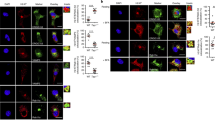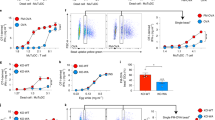Abstract
Although plasmacytoid dendritic cells (pDCs) respond to virus replication in a nonspecific way by producing large amounts of type I interferon, a rapid, direct function for pDCs in activating antiviral lymphocytes is less apparent. Here we show that pDCs were able to rapidly initiate antigen-specific antiviral CD8+ T cell responses. After being exposed to virus, pDCs efficiently and rapidly internalized exogenous viral antigens and then presented those antigens on major histocompatibility complex (MHC) class I to CD8+ T cells. Processing of exogenous antigen occurred in endocytic organelles and did not require transit of antigen to the cytosol. Intracellular stores of MHC class I partially localized together with the transferrin receptor and internalized transferrin in endosomes, which suggested that such recycling endosomes are sites for loading peptide onto MHC class I or for peptide transit. Our data demonstrate that pDCs use 'ready-made' stores of MHC class I to rapidly present exogenous antigen to CD8+ T cells.
This is a preview of subscription content, access via your institution
Access options
Subscribe to this journal
Receive 12 print issues and online access
$209.00 per year
only $17.42 per issue
Buy this article
- Purchase on Springer Link
- Instant access to full article PDF
Prices may be subject to local taxes which are calculated during checkout





Similar content being viewed by others
References
Banchereau, J. & Steinman, R.M. Dendritic cells and the control of immunity. Nature 392, 245–252 (1998).
Shortman, K. & Liu, Y.J. Mouse and human dendritic cell subtypes. Nat. Rev. Immunol. 2, 151–161 (2002).
Mellman, I. & Steinman, R.M. Dendritic cells: specialized and regulated antigen processing machines. Cell 106, 255–258 (2001).
Reis e Sousa, C. Dendritic cells in a mature age. Nat. Rev. Immunol. 6, 476–483 (2006).
Watts, C. The exogenous pathway for antigen presentation on major histocompatibility complex class II and CD1 molecules. Nat. Immunol. 5, 685–692 (2004).
Trombetta, E.S. & Mellman, I. Cell biology of antigen processing in vitro and in vivo. Annu. Rev. Immunol. 23, 975–1028 (2005).
Pierre, P. et al. Developmental regulation of MHC class II transport in mouse dendritic cells. Nature 388, 787–792 (1997).
Turley, S.J. et al. Transport of peptide-MHC class II complexes in developing dendritic cells. Science 288, 522–527 (2000).
Chow, A., Toomre, D., Garrett, W. & Mellman, I. Dendritic cell maturation triggers retrograde MHC class II transport from lysosomes to the plasma membrane. Nature 418, 988–994 (2002).
Inaba, K. et al. The formation of immunogenic major histocompatibility complex class II-peptide ligands in lysosomal compartments of dendritic cells is regulated by inflammatory stimuli. J. Exp. Med. 191, 927–936 (2000).
Cresswell, P., Ackerman, A.L., Giodini, A., Peaper, D.R. & Wearsch, P.A. Mechanisms of MHC class I-restricted antigen processing and cross-presentation. Immunol. Rev. 207, 145–157 (2005).
Shen, L. & Rock, K.L. Priming of T cells by exogenous antigen cross-presented on MHC class I molecules. Curr. Opin. Immunol. 18, 85–91 (2006).
Huang, A.Y., Bruce, A.T., Pardoll, D.M. & Levitsky, H.I. In vivo cross-priming of MHC class I-restricted antigens requires the TAP transporter. Immunity 4, 349–355 (1996).
Shen, L., Sigal, L.J., Boes, M. & Rock, K.L. Important role of cathepsin S in generating peptides for TAP-independent MHC class I crosspresentation in vivo. Immunity 21, 155–165 (2004).
Guermonprez, P. et al. ER-phagosome fusion defines an MHC class I cross-presentation compartment in dendritic cells. Nature 425, 397–402 (2003).
Houde, M. et al. Phagosomes are competent organelles for antigen cross-presentation. Nature 425, 402–406 (2003).
Touret, N. et al. Quantitative and dynamic assessment of the contribution of the ER to phagosome formation. Cell 123, 157–170 (2005).
Asselin-Paturel, C. et al. Type I interferon dependence of plasmacytoid dendritic cell activation and migration. J. Exp. Med. 201, 1157–1167 (2005).
Liu, Y.J. IPC: professional type 1 interferon-producing cells and plasmacytoid dendritic cell precursors. Annu. Rev. Immunol. 23, 275–306 (2005).
Garcia-Sastre, A. & Biron, C.A. Type 1 interferons and the virus-host relationship: a lesson in detente. Science 312, 879–882 (2006).
Yoneyama, H. et al. Plasmacytoid DCs help lymph node DCs to induce anti-HSV CTLs. J. Exp. Med. 202, 425–435 (2005).
Smit, J.J., Rudd, B.D. & Lukacs, N.W. Plasmacytoid dendritic cells inhibit pulmonary immunopathology and promote clearance of respiratory syncytial virus. J. Exp. Med. 203, 1153–1159 (2006).
Kuchtey, J., Chefalo, P.J., Gray, R.C., Ramachandra, L. & Harding, C.V. Enhancement of dendritic cell antigen cross-presentation by CpG DNA involves type I IFN and stabilization of class I MHC mRNA. J. Immunol. 175, 2244–2251 (2005).
Fonteneau, J.F. et al. Activation of influenza virus-specific CD4+ and CD8+ T cells: a new role for plasmacytoid dendritic cells in adaptive immunity. Blood 101, 3520–3526 (2003).
Moseman, E.A. et al. Human plasmacytoid dendritic cells activated by CpG oligodeoxynucleotides induce the generation of CD4+CD25+ regulatory T cells. J. Immunol. 173, 4433–4442 (2004).
Gilliet, M. & Liu, Y.J. Generation of human CD8 T regulatory cells by CD40 ligand-activated plasmacytoid dendritic cells. J. Exp. Med. 195, 695–704 (2002).
Ito, T. et al. Plasmacytoid dendritic cells prime IL-10-producing T regulatory cells by inducible costimulator ligand. J. Exp. Med. 204, 105–115 (2007).
Stern, L.J., Potolicchio, I. & Santambrogio, L. MHC class II compartment subtypes: structure and function. Curr. Opin. Immunol. 18, 64–69 (2006).
MacAry, P.A. et al. Mobilization of MHC class I molecules from late endosomes to the cell surface following activation of CD34-derived human Langerhans cells. Proc. Natl. Acad. Sci. USA 98, 3982–3987 (2001).
Gromme, M. et al. Recycling MHC class I molecules and endosomal peptide loading. Proc. Natl. Acad. Sci. USA 96, 10326–10331 (1999).
Guiducci, C. et al. Properties regulating the nature of the plasmacytoid dendritic cell response to Toll-like receptor 9 activation. J. Exp. Med. 203, 1999–2008 (2006).
Lizee, G. et al. Control of dendritic cell cross-presentation by the major histocompatibility complex class I cytoplasmic domain. Nat. Immunol. 4, 1065–1073 (2003).
van Weert, A.W., Geuze, H.J., Groothuis, B. & Stoorvogel, W. Primaquine interferes with membrane recycling from endosomes to the plasma membrane through a direct interaction with endosomes which does not involve neutralisation of endosomal pH nor osmotic swelling of endosomes. Eur. J. Cell Biol. 79, 394–399 (2000).
Delamarre, L., Holcombe, H. & Mellman, I. Presentation of exogenous antigens on major histocompatibility complex (MHC) class I and MHC class II molecules is differentially regulated during dendritic cell maturation. J. Exp. Med. 198, 111–122 (2003).
Neumann, A.U. et al. Hepatitis C viral dynamics in vivo and the antiviral efficacy of interferon-alpha therapy. Science 282, 103–107 (1998).
Grouard, G. et al. The enigmatic plasmacytoid T cells develop into dendritic cells with interleukin (IL)-3 and CD40-ligand. J. Exp. Med. 185, 1101–1111 (1997).
Siegal, F.P. et al. The nature of the principal type 1 interferon-producing cells in human blood. Science 284, 1835–1837 (1999).
Cella, M. et al. Plasmacytoid monocytes migrate to inflamed lymph nodes and produce large amounts of type I interferon. Nat. Med. 5, 919–923 (1999).
Honda, K. et al. IRF-7 is the master regulator of type-I interferon-dependent immune responses. Nature 434, 772–777 (2005).
Hoeffel, G. et al. Antigen crosspresentation by human plasmacytoid dendritic cells. Immunity 27, 481–492 (2007).
Itano, A.A. et al. Distinct dendritic cell populations sequentially present antigen to CD4 T cells and stimulate different aspects of cell-mediated immunity. Immunity 19, 47–57 (2003).
Acknowledgements
We thank A.K. Palucka, M. Pypaert, J. Shay, Y. Xu and C. Xu. Anti-ERGIC-53 was provided by A. Satoh (Yale University School of Medicine). Supported by the Baylor Health Care Systems Foundation, the Dana Foundation (J.E.C.), the Ludwig Institute for Cancer Research, the National Institutes of Health (R01 CA078846-08, R01 AI068842-01 and U19 AI057234 to J.B.; R01 R37AI34098 to I.M.) and the Italian Foundation for Cancer Research (T.D.).
Author information
Authors and Affiliations
Contributions
T.D. designed, did and analyzed experiments; B.C., A.S., J.E.C. and S.C. designed, did and analyzed imaging experiments; A.P. and Y.X. assisted in cellular isolation and analysis; M.M. provided influenza virus–specific T cell lines; J.E.C., J.B., I.M. and T.D. prepared the manuscript; J.B. and I.M. provided intellectual guidance on the project; and J.E.C. conceptualized and designed the project.
Corresponding authors
Ethics declarations
Competing interests
Tiziana Di Pucchio, Bithi Chatterjee, Anna Smed-Sörensen, Sandra Clayton, Adam Palazzo, Monica Montes, Yaming Xue, Ira Mellman, Jacques Banchereau & John E Connolly B.C., A.S.-S. and I.M. are employees of Genentech.
Supplementary information
Supplementary Text and Figures
Supplementary Figures 1–7 (PDF 299 kb)
Rights and permissions
About this article
Cite this article
Di Pucchio, T., Chatterjee, B., Smed-Sörensen, A. et al. Direct proteasome-independent cross-presentation of viral antigen by plasmacytoid dendritic cells on major histocompatibility complex class I. Nat Immunol 9, 551–557 (2008). https://doi.org/10.1038/ni.1602
Received:
Accepted:
Published:
Issue Date:
DOI: https://doi.org/10.1038/ni.1602
This article is cited by
-
Long-term cigarette smoke exposure dysregulates pulmonary T cell response and IFN-γ protection to influenza virus in mouse
Respiratory Research (2021)
-
Differential uptake of three clinically relevant allergens by human plasmacytoid dendritic cells
Clinical and Molecular Allergy (2021)
-
Revisiting cellular immune response to oncogenic Marek’s disease virus: the rising of avian T-cell immunity
Cellular and Molecular Life Sciences (2020)
-
Langerin-mediated internalization of a modified peptide routes antigens to early endosomes and enhances cross-presentation by human Langerhans cells
Cellular & Molecular Immunology (2017)
-
Lipid bodies containing oxidatively truncated lipids block antigen cross-presentation by dendritic cells in cancer
Nature Communications (2017)



